Unit 9 What does he look like Period 4 Section B (2a-2c)课件(共48张PPT)
文档属性
| 名称 | Unit 9 What does he look like Period 4 Section B (2a-2c)课件(共48张PPT) | 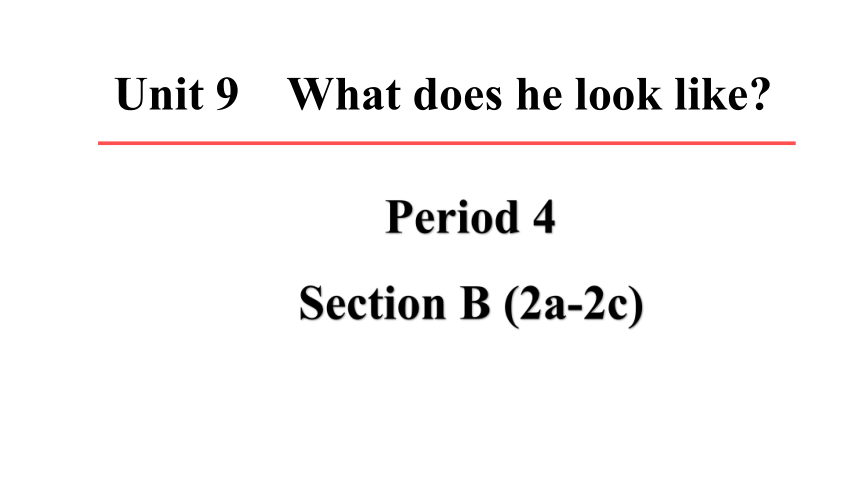 | |
| 格式 | pptx | ||
| 文件大小 | 16.2MB | ||
| 资源类型 | 教案 | ||
| 版本资源 | 人教新目标(Go for it)版 | ||
| 科目 | 英语 | ||
| 更新时间 | 2023-12-17 09:59:33 | ||
图片预览

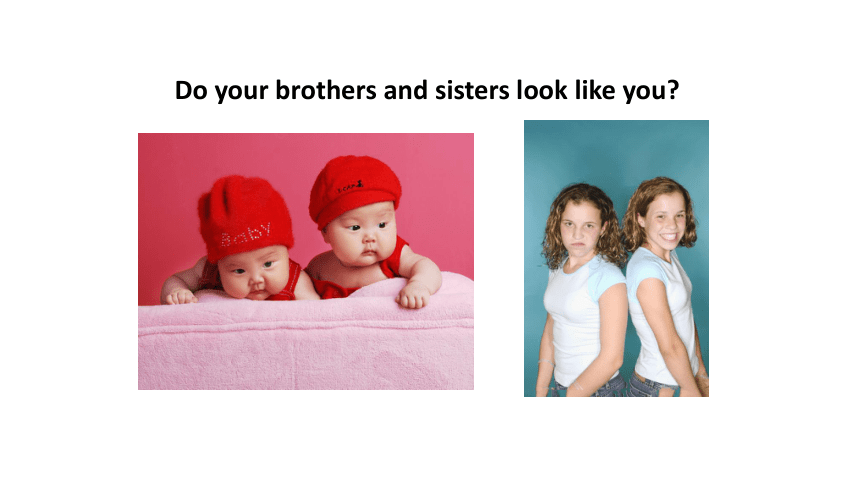
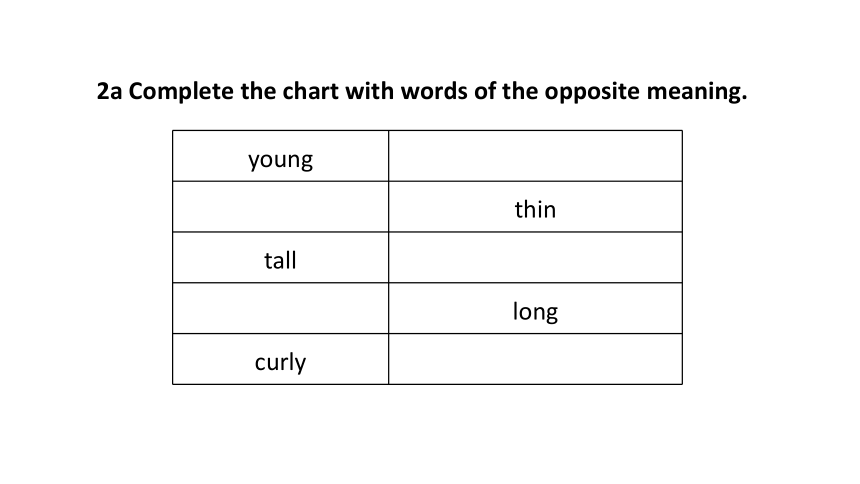
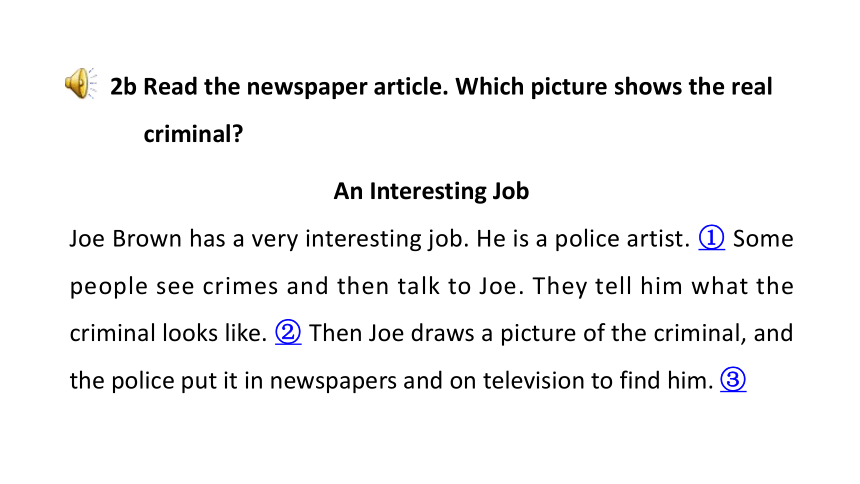
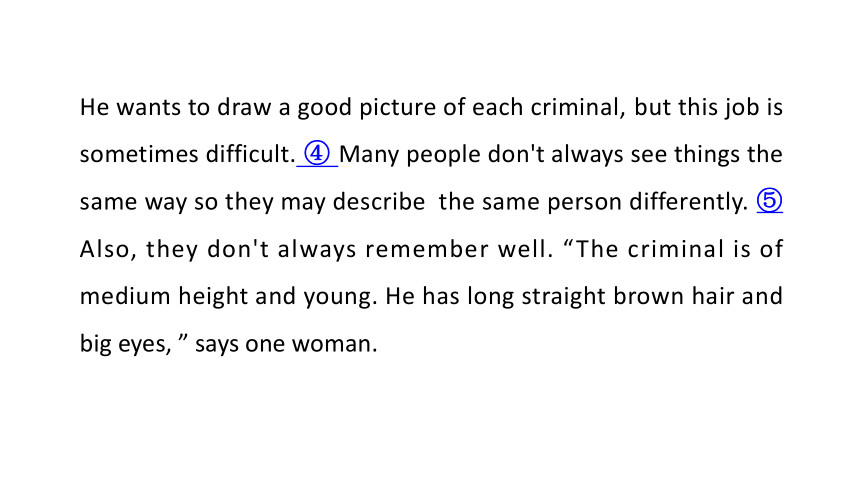
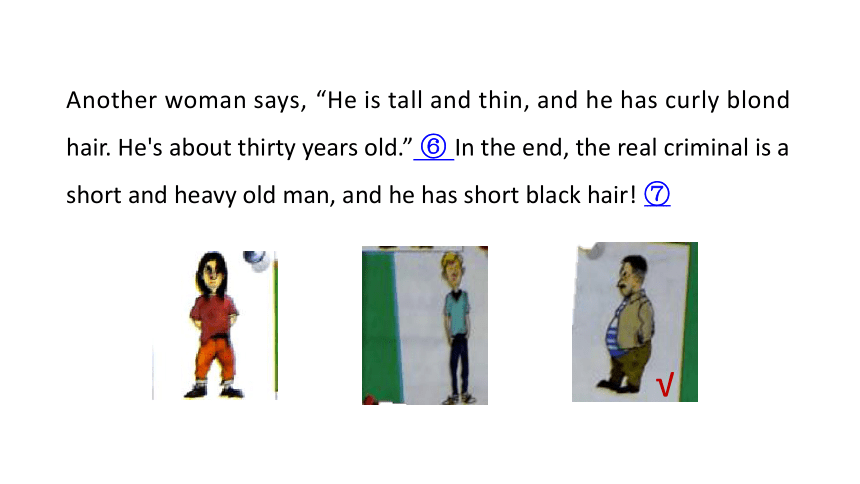
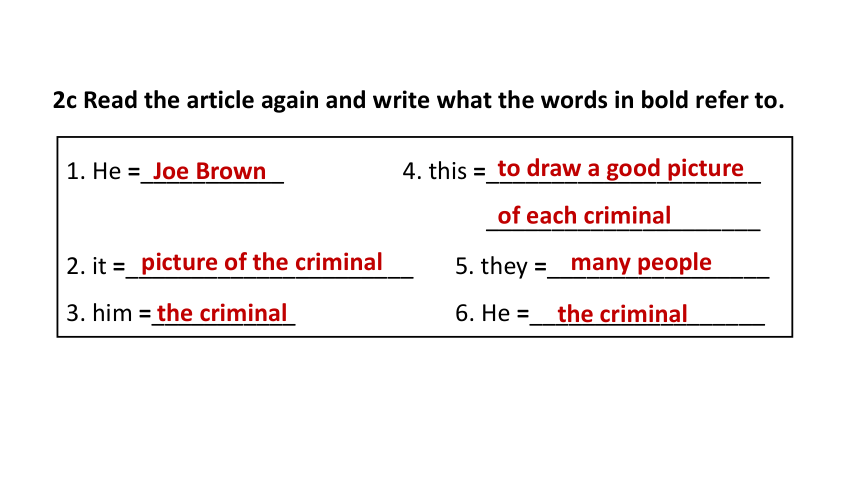
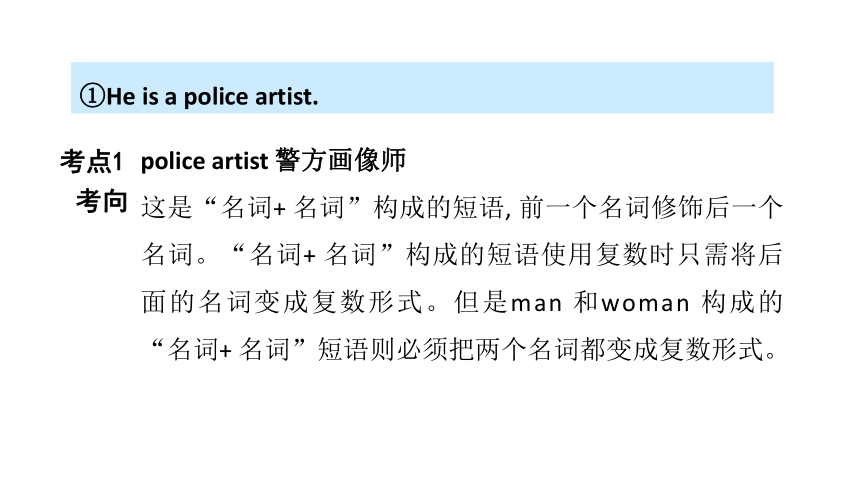
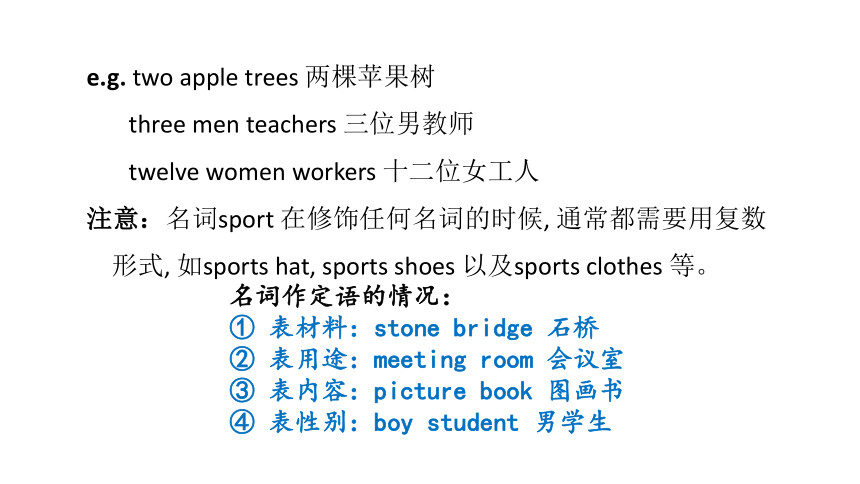
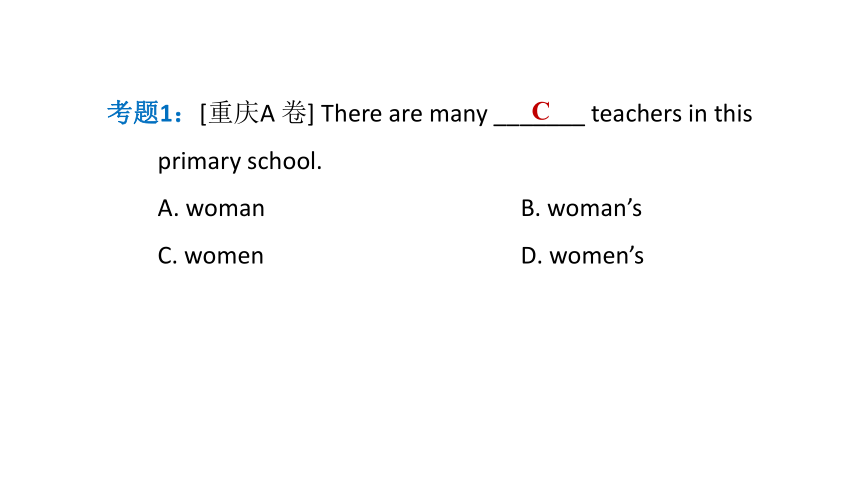
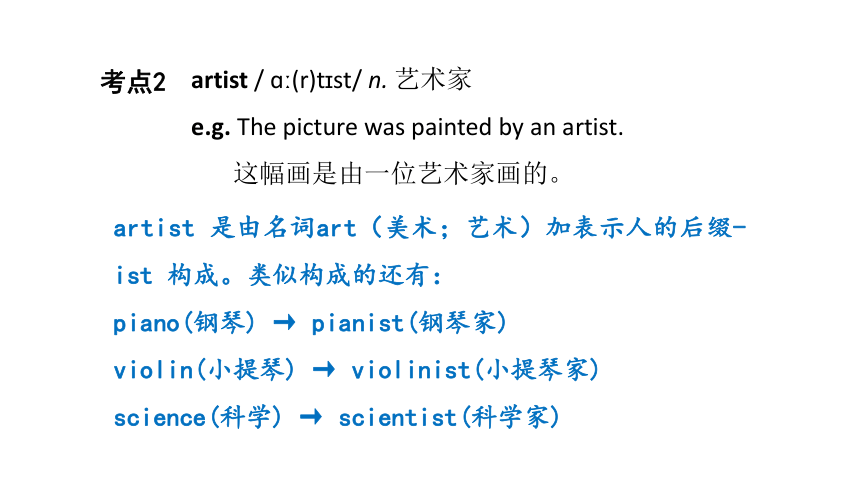
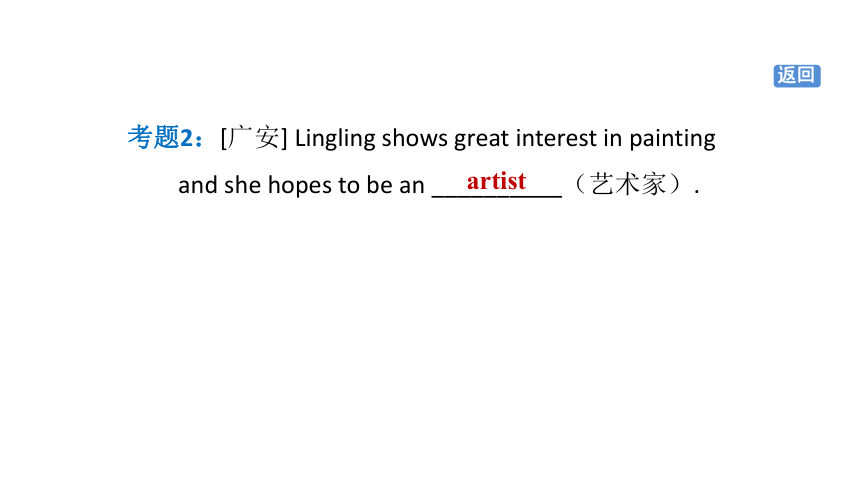
文档简介
(共48张PPT)
Period 4
Section B (2a-2c)
Unit 9 What does he look like
Do your brothers and sisters look like you
2a Complete the chart with words of the opposite meaning.
young
thin
tall
long
curly
2b Read the newspaper article. Which picture shows the real criminal
An Interesting Job
Joe Brown has a very interesting job. He is a police artist. ① Some people see crimes and then talk to Joe. They tell him what the criminal looks like. ② Then Joe draws a picture of the criminal, and the police put it in newspapers and on television to find him. ③
He wants to draw a good picture of each criminal, but this job is sometimes difficult. ④ Many people don't always see things the same way so they may describe the same person differently. ⑤ Also, they don't always remember well. “The criminal is of medium height and young. He has long straight brown hair and big eyes, ” says one woman.
Another woman says, “He is tall and thin, and he has curly blond hair. He's about thirty years old.” ⑥ In the end, the real criminal is a short and heavy old man, and he has short black hair! ⑦
√
2c Read the article again and write what the words in bold refer to.
1. He =___________ 4. this =_____________________
_____________________
2. it =______________________ 5. they =_________________
3. him =___________ 6. He =__________________
Joe Brown
to draw a good picture
of each criminal
picture of the criminal
many people
the criminal
the criminal
①He is a police artist.
police artist 警方画像师
这是“名词+ 名词”构成的短语, 前一个名词修饰后一个名词。“名词+ 名词”构成的短语使用复数时只需将后面的名词变成复数形式。但是man 和woman 构成的 “名词+ 名词”短语则必须把两个名词都变成复数形式。
考点1
考向
e.g. two apple trees 两棵苹果树
three men teachers 三位男教师
twelve women workers 十二位女工人
注意:名词sport 在修饰任何名词的时候, 通常都需要用复数形式, 如sports hat, sports shoes 以及sports clothes 等。
名词作定语的情况:
① 表材料:stone bridge 石桥
② 表用途:meeting room 会议室
③ 表内容:picture book 图画书
④ 表性别:boy student 男学生
考题1:[重庆A 卷] There are many _______ teachers in this primary school.
A. woman B. woman’s
C. women D. women’s
C
artist / ɑ (r)t st/ n. 艺术家
e.g. The picture was painted by an artist.
这幅画是由一位艺术家画的。
考点2
artist 是由名词art(美术;艺术)加表示人的后缀-ist 构成。类似构成的还有:
piano(钢琴) → pianist(钢琴家)
violin(小提琴) → violinist(小提琴家)
science(科学) → scientist(科学家)
考题2:[广安] Lingling shows great interest in painting and she hopes to be an __________(艺术家).
返回
artist
②They tell him what the criminal looks like.
特殊疑问词引导的宾语从句
本句是what 引导的宾语从句,作tell 的宾语。
They tell him what the criminal looks like.
what 作looks like 的宾语,即“the criminal looks like what”。
e.g. I don’t know who you are talking with.
我不知道你在和谁说话。
考点3
宾语从句要用陈述句语序
考向
考题3:[连云港] —Sarah, do you know _________
—It’s on April 23.
A. what is World Book Day B. what World Book Day is
C. when is World Book Day D. when World Book Day is
【点拨】用语法分析法。宾语从句应用陈述句语序,排除选项A 和C;又根据答语It’s on April 23. 可知,询问的是时间。
返回
D
③Then Joe draws a picture of the criminal, and the police put it in newspapers and on television to find him.
put /p t/ v. 放
put 用作及物动词, 此处意为“放;摆;搁;安置”,常用于以下结构:
(1) put + 名词/ 代词+ 介词短语,put ... in/on ... 把……放到……里/ 上
e.g. Please put the book on the desk. 请把书放在书桌上。
(2) put + 名词/ 代词+ 副词(短语)
e.g. Put the chair here, please. 请把那把椅子放在这里。
考点4
考向
put 的常见短语:
① put off 推迟
② put out 扑灭
③ put up 举起;张贴
④ put on 穿上
⑤ put down 放下
⑥ put away 把……收起来
考题4:—Where’s my English book, Mary
—Oh, I saw you ________ it in your schoolbag.
A. buy B. bring C. take D. put
【点拨】用词义辨析法。buy买;bring 带来;take 带走;put 放。结合答句后面的“in your schoolbag”可知把英语书“放”进书包符合逻辑。
D
返回
④He wants to draw a good picture of each criminal...
(高频) each /i t / adj. & pron. 每个;各自
e.g. Each day is a fresh beginning. 每一天都是一个新的开始。
Each student has a new bike. = Each of the students has a new bike. = The students each have a new bike. = The students have a new bike each. 每个学生都有一辆新自行车。
Every student has a new bike. 每个学生都有一辆新自行车。
考点5
修饰可数名词单数,作定语
拓展:each 还可用作代词,具体用法如下:
含义 用法 示例
作 主语 单独作主语,谓语动词用单数。 The boys come from Paris, and each knows Notre Dame de Paris well.
这些男孩来自巴黎,并且每个人
都对巴黎圣母院很了解。
“each of + 复数名词/ 代词”作主语, 谓语动词用单数。 Each of them is riding a shared bike.
他们每个人骑着一辆共享单车。
作同 位语 放在主语后,谓语动词用复数。 They each want to scan the QR code.
他们每个人都想扫二维码。
辨析:each 与every
each 指两者或两者以上中的“每一个”,强调个体。可用作形容词或代词,可作定语、状语、主语或同位语。
every 指三者或三者以上范围中的“每一个”,强调整体。用作形容词,作定语。
every 只能作形容词,不可单独使用,其后不可接of。
考题5: [盐城] Each of us _______ a life goal, which will guide us to a bright future.
A. has B. have
C. will have D. had
【点拨】用语法分析法。本句在陈述一个事实,故用一般现在时;Each of us 作主语,谓语动词要用单数。
A
考题6:[济南改编] There are many flowers and trees on _______ side of the Century Road.
A. each B. other C. both D. all
A
返回
⑤Many people don’t always see things the same way so they may describe the same person differently.
not always 不总是
当句子中有all, every, both, always 等词时,否定词not 无论用在主语还是谓语部分中,都表示部分否定。
考点6
考向
表示完全否定要用no, none, nobody, nothing, neither, never 等词。
表部分否定
e.g. We don’t always get to school by bike.
我们并不总是骑自行车到学校。
Not all men can be bosses. 不是所有的人都能当老板。
Not every story is interesting. 不是每个故事都有趣。
I don’t want both the books. 我并不是两本书都要。
Nobody wants to miss the movie. 没有人想错过那部电影。
way/we / n. 方式; 路线
与介词in 连用时, way 前有this/that/the 时, in 可省略; 但如果是在句首, 则in 不能省略。in the same way“用相同方式”。
e.g. She has her own ways to make classes lively and interesting. 她有自己的方法使课堂生动有趣。
The little cat catches many fish (in) this way.
小猫用这种方法捉了很多鱼。
考点7
考向
I’ll do it in the same way as you do.
我将用和你一样的方法做这件事。
What is another way of saying “TV”
= What is another way to say “TV”
“电视” 的另一种说法是什么?
the way of doing sth. = the way to do sth.
“做某事的方法”
way 相关短语:
① on one’s way to + 地点名词 在某人去……的路上
② by the way 顺便说一下
③ get in the way of 妨碍,阻碍
④ on the/one’s way 在路上
考题7:[重庆A卷改编] 加入社团是一个很好的交友方式。
Joining a club is a good way _________ _____________ friends.
to make
/ of making
so /s / conj. 因此,所以 adv. 这么,那么,如此
so 用作并列连词, 表示“因此, 所以”。
e.g. I heard some noise outside, so I went out of the room to see why.
我听到外面有一些噪音,所以我走出房间去看看为什么。
考点8
考向
小贴士:
在表达第二个人或事物与第一个人或事物有同样情况的时候,通常要用“so + 倒装句”,意为“……也是”。
e.g. Jimmy is good at English. So is his brother.
如果上下文表达的是同
一个人或事物的情况时,通常要用“so + 陈述句”,意为“的确如此”。
e.g. — It’s a fine day today. —So it is.
拓展:so 还可用作副词,表示“这么,那么,如此”。
(1) 用于形容情感或品质的程度,或数量的多少。
e.g. You are so kind. 你真是太好了。
There are only so many hours in a day.
一天只有那么多小时。
(2) 用于代替前面陈述的事物,以避免重复,常用于think, believe, do, say 之类的动词之后,意为“如此,这样”。
e.g. —Will he pass the exam 他会通过这次考试吗?
—I don’t think so. 我不这么认为。
He asked me to write to him and I did so.
他叫我写信给他,我照做了。
(3) 用于否定句中,以比较人或物,常用于not so ... as ... 结构中,意为“不如……这么……,不像……那样……”。
e.g. She is not so clever as we think.
她不如我们想象的那么聪明。
考题8:[天津] It’s not always safe to pay over the Internet, _______ you should be careful.
A. so B. after C. because D. as soon as
【点拨】用逻辑推理法。由前面句意“网上支付不总是安全的”可推知后面句意为“所以你应该小心”。故用so 来连接。
A
differently /'d f r ntli/ adv. 不同地
differently 相当于in different ways, 常用来修饰动词或句子。
e.g. Sam saw the world differently from everybody else.
萨姆看这个世界的方式与其他人不同。
English is different from Chinese. 英语和汉语不同。
There are a few differences between the twins.
这对双胞胎之间有些不同。
考点9
考向
differently 的词形转换:
different adj . 不同的;有差异的
difference n . 不同;差异
考题9:People in different countries behave ______________ (different) when they eat dinner.
返回
differently
⑥Another woman says...
another/ n (r) / adj.& pron. 另一; 又一
考点10
another 用作形容词, 意为 “另一;又一”, 修饰可数名词单数。
e.g. Would you like another apple
你想再要一个苹果吗?
The cakes are nice. I want to have another two.
蛋糕很好吃,我还想要两个。
考向
Ten children are in the classroom. Two of them are reading, and the other eight are writing.
十个孩子在教室里。其中两个在读书,其他八个在写。
小贴士:
① “another+ 数词”表示总数未知;
② “the other+ 数词” 表示总数已知。
拓展:another 用作代词,泛指三者或者三者以上同类事物中的“另一个”。
e.g. I do not like this one; please show me another.
我不喜欢这一个, 请给我看另一个。
辨析:another, other, the other, others与the others
another 泛指同类事物中三者或三者以上的“另一个”
other “另外的,其他的”,后常接复数名词
the other 两者中的另一个,常用于“one...the other...”结构中,意为“一个……,另一个……”
others 剩余的另一些(并非全部),some...others... 意为“一些……,一些……”
the others 指一定范围内剩余的全部,some...the others... 意为“一些……,其余的……”
e.g. I have two pens. One is white and the other is black. Today, I want to buy another one. 我有两支钢笔,一支是白色的,另一支是黑色的。今天,我想再买一支。
Other problems may follow. 其他问题也许会随之而来。
Some students are writing, others ( = other students) are reading and the others ( = the other students) are listening.
一些学生在写,另一些在读,其他的在听。
考题10:[眉山] I have finished reading this magazine. Please give me a one.
nother
考题11:[包头] Some animals move from one place to ________ at certain times of the year.
A. another B. other
C. the other D. others
【点拨】句意为“ 有些动物在一年中的特定时间从一个地方迁移到另一个地方”。由语境可知用another。
A
返回
⑦In the end, the real criminal is a short and heavy old man, and he has short black hair!
(高频) in the end 最后;终于
in the end = at last / finally,在句中作状语,其中end 作名词,意为“结尾;尽头”。in the end 的反义短语是at first“起初”。
e.g. He studied hard and he passed the exam in the end.
他努力学习,最后通过了考试。
考点11
考向
辨析:the end of, at the end of 与by the end of
the end of “……的尽头”,可跟地点
at the end of “在……的末尾”,可跟时间或地点
by the end of “到……结束时;到……为止”,可跟时间
e.g. We walked to the end of the road.
我们走到了路的尽头。
They’ll come at the end of March.
他们将在3 月底到来。
I want to learn five English songs by the end of next year.
我想在明年年底前学会5 首英文歌曲。
考题12:The man tried several times (尝试了几次)to start the car, and he succeeded(成功)________.
A. in the past B. in the end
C. at first D. at once
【点拨】用短语辨析法。In the past 在过去;in the end 最后;at first 首先;at once 立刻。四个选项中只有in the end 可使句意完整、通顺。
返回
B
本节课主要学习了An Interesting Job这篇课文, 掌握了知识点artist, talk to, draw a picture of, put, each, way, so, describe, differently, another, in the end, real的用法, 并回答了与文章内容相关的问题。
Period 4
Section B (2a-2c)
Unit 9 What does he look like
Do your brothers and sisters look like you
2a Complete the chart with words of the opposite meaning.
young
thin
tall
long
curly
2b Read the newspaper article. Which picture shows the real criminal
An Interesting Job
Joe Brown has a very interesting job. He is a police artist. ① Some people see crimes and then talk to Joe. They tell him what the criminal looks like. ② Then Joe draws a picture of the criminal, and the police put it in newspapers and on television to find him. ③
He wants to draw a good picture of each criminal, but this job is sometimes difficult. ④ Many people don't always see things the same way so they may describe the same person differently. ⑤ Also, they don't always remember well. “The criminal is of medium height and young. He has long straight brown hair and big eyes, ” says one woman.
Another woman says, “He is tall and thin, and he has curly blond hair. He's about thirty years old.” ⑥ In the end, the real criminal is a short and heavy old man, and he has short black hair! ⑦
√
2c Read the article again and write what the words in bold refer to.
1. He =___________ 4. this =_____________________
_____________________
2. it =______________________ 5. they =_________________
3. him =___________ 6. He =__________________
Joe Brown
to draw a good picture
of each criminal
picture of the criminal
many people
the criminal
the criminal
①He is a police artist.
police artist 警方画像师
这是“名词+ 名词”构成的短语, 前一个名词修饰后一个名词。“名词+ 名词”构成的短语使用复数时只需将后面的名词变成复数形式。但是man 和woman 构成的 “名词+ 名词”短语则必须把两个名词都变成复数形式。
考点1
考向
e.g. two apple trees 两棵苹果树
three men teachers 三位男教师
twelve women workers 十二位女工人
注意:名词sport 在修饰任何名词的时候, 通常都需要用复数形式, 如sports hat, sports shoes 以及sports clothes 等。
名词作定语的情况:
① 表材料:stone bridge 石桥
② 表用途:meeting room 会议室
③ 表内容:picture book 图画书
④ 表性别:boy student 男学生
考题1:[重庆A 卷] There are many _______ teachers in this primary school.
A. woman B. woman’s
C. women D. women’s
C
artist / ɑ (r)t st/ n. 艺术家
e.g. The picture was painted by an artist.
这幅画是由一位艺术家画的。
考点2
artist 是由名词art(美术;艺术)加表示人的后缀-ist 构成。类似构成的还有:
piano(钢琴) → pianist(钢琴家)
violin(小提琴) → violinist(小提琴家)
science(科学) → scientist(科学家)
考题2:[广安] Lingling shows great interest in painting and she hopes to be an __________(艺术家).
返回
artist
②They tell him what the criminal looks like.
特殊疑问词引导的宾语从句
本句是what 引导的宾语从句,作tell 的宾语。
They tell him what the criminal looks like.
what 作looks like 的宾语,即“the criminal looks like what”。
e.g. I don’t know who you are talking with.
我不知道你在和谁说话。
考点3
宾语从句要用陈述句语序
考向
考题3:[连云港] —Sarah, do you know _________
—It’s on April 23.
A. what is World Book Day B. what World Book Day is
C. when is World Book Day D. when World Book Day is
【点拨】用语法分析法。宾语从句应用陈述句语序,排除选项A 和C;又根据答语It’s on April 23. 可知,询问的是时间。
返回
D
③Then Joe draws a picture of the criminal, and the police put it in newspapers and on television to find him.
put /p t/ v. 放
put 用作及物动词, 此处意为“放;摆;搁;安置”,常用于以下结构:
(1) put + 名词/ 代词+ 介词短语,put ... in/on ... 把……放到……里/ 上
e.g. Please put the book on the desk. 请把书放在书桌上。
(2) put + 名词/ 代词+ 副词(短语)
e.g. Put the chair here, please. 请把那把椅子放在这里。
考点4
考向
put 的常见短语:
① put off 推迟
② put out 扑灭
③ put up 举起;张贴
④ put on 穿上
⑤ put down 放下
⑥ put away 把……收起来
考题4:—Where’s my English book, Mary
—Oh, I saw you ________ it in your schoolbag.
A. buy B. bring C. take D. put
【点拨】用词义辨析法。buy买;bring 带来;take 带走;put 放。结合答句后面的“in your schoolbag”可知把英语书“放”进书包符合逻辑。
D
返回
④He wants to draw a good picture of each criminal...
(高频) each /i t / adj. & pron. 每个;各自
e.g. Each day is a fresh beginning. 每一天都是一个新的开始。
Each student has a new bike. = Each of the students has a new bike. = The students each have a new bike. = The students have a new bike each. 每个学生都有一辆新自行车。
Every student has a new bike. 每个学生都有一辆新自行车。
考点5
修饰可数名词单数,作定语
拓展:each 还可用作代词,具体用法如下:
含义 用法 示例
作 主语 单独作主语,谓语动词用单数。 The boys come from Paris, and each knows Notre Dame de Paris well.
这些男孩来自巴黎,并且每个人
都对巴黎圣母院很了解。
“each of + 复数名词/ 代词”作主语, 谓语动词用单数。 Each of them is riding a shared bike.
他们每个人骑着一辆共享单车。
作同 位语 放在主语后,谓语动词用复数。 They each want to scan the QR code.
他们每个人都想扫二维码。
辨析:each 与every
each 指两者或两者以上中的“每一个”,强调个体。可用作形容词或代词,可作定语、状语、主语或同位语。
every 指三者或三者以上范围中的“每一个”,强调整体。用作形容词,作定语。
every 只能作形容词,不可单独使用,其后不可接of。
考题5: [盐城] Each of us _______ a life goal, which will guide us to a bright future.
A. has B. have
C. will have D. had
【点拨】用语法分析法。本句在陈述一个事实,故用一般现在时;Each of us 作主语,谓语动词要用单数。
A
考题6:[济南改编] There are many flowers and trees on _______ side of the Century Road.
A. each B. other C. both D. all
A
返回
⑤Many people don’t always see things the same way so they may describe the same person differently.
not always 不总是
当句子中有all, every, both, always 等词时,否定词not 无论用在主语还是谓语部分中,都表示部分否定。
考点6
考向
表示完全否定要用no, none, nobody, nothing, neither, never 等词。
表部分否定
e.g. We don’t always get to school by bike.
我们并不总是骑自行车到学校。
Not all men can be bosses. 不是所有的人都能当老板。
Not every story is interesting. 不是每个故事都有趣。
I don’t want both the books. 我并不是两本书都要。
Nobody wants to miss the movie. 没有人想错过那部电影。
way/we / n. 方式; 路线
与介词in 连用时, way 前有this/that/the 时, in 可省略; 但如果是在句首, 则in 不能省略。in the same way“用相同方式”。
e.g. She has her own ways to make classes lively and interesting. 她有自己的方法使课堂生动有趣。
The little cat catches many fish (in) this way.
小猫用这种方法捉了很多鱼。
考点7
考向
I’ll do it in the same way as you do.
我将用和你一样的方法做这件事。
What is another way of saying “TV”
= What is another way to say “TV”
“电视” 的另一种说法是什么?
the way of doing sth. = the way to do sth.
“做某事的方法”
way 相关短语:
① on one’s way to + 地点名词 在某人去……的路上
② by the way 顺便说一下
③ get in the way of 妨碍,阻碍
④ on the/one’s way 在路上
考题7:[重庆A卷改编] 加入社团是一个很好的交友方式。
Joining a club is a good way _________ _____________ friends.
to make
/ of making
so /s / conj. 因此,所以 adv. 这么,那么,如此
so 用作并列连词, 表示“因此, 所以”。
e.g. I heard some noise outside, so I went out of the room to see why.
我听到外面有一些噪音,所以我走出房间去看看为什么。
考点8
考向
小贴士:
在表达第二个人或事物与第一个人或事物有同样情况的时候,通常要用“so + 倒装句”,意为“……也是”。
e.g. Jimmy is good at English. So is his brother.
如果上下文表达的是同
一个人或事物的情况时,通常要用“so + 陈述句”,意为“的确如此”。
e.g. — It’s a fine day today. —So it is.
拓展:so 还可用作副词,表示“这么,那么,如此”。
(1) 用于形容情感或品质的程度,或数量的多少。
e.g. You are so kind. 你真是太好了。
There are only so many hours in a day.
一天只有那么多小时。
(2) 用于代替前面陈述的事物,以避免重复,常用于think, believe, do, say 之类的动词之后,意为“如此,这样”。
e.g. —Will he pass the exam 他会通过这次考试吗?
—I don’t think so. 我不这么认为。
He asked me to write to him and I did so.
他叫我写信给他,我照做了。
(3) 用于否定句中,以比较人或物,常用于not so ... as ... 结构中,意为“不如……这么……,不像……那样……”。
e.g. She is not so clever as we think.
她不如我们想象的那么聪明。
考题8:[天津] It’s not always safe to pay over the Internet, _______ you should be careful.
A. so B. after C. because D. as soon as
【点拨】用逻辑推理法。由前面句意“网上支付不总是安全的”可推知后面句意为“所以你应该小心”。故用so 来连接。
A
differently /'d f r ntli/ adv. 不同地
differently 相当于in different ways, 常用来修饰动词或句子。
e.g. Sam saw the world differently from everybody else.
萨姆看这个世界的方式与其他人不同。
English is different from Chinese. 英语和汉语不同。
There are a few differences between the twins.
这对双胞胎之间有些不同。
考点9
考向
differently 的词形转换:
different adj . 不同的;有差异的
difference n . 不同;差异
考题9:People in different countries behave ______________ (different) when they eat dinner.
返回
differently
⑥Another woman says...
another/ n (r) / adj.& pron. 另一; 又一
考点10
another 用作形容词, 意为 “另一;又一”, 修饰可数名词单数。
e.g. Would you like another apple
你想再要一个苹果吗?
The cakes are nice. I want to have another two.
蛋糕很好吃,我还想要两个。
考向
Ten children are in the classroom. Two of them are reading, and the other eight are writing.
十个孩子在教室里。其中两个在读书,其他八个在写。
小贴士:
① “another+ 数词”表示总数未知;
② “the other+ 数词” 表示总数已知。
拓展:another 用作代词,泛指三者或者三者以上同类事物中的“另一个”。
e.g. I do not like this one; please show me another.
我不喜欢这一个, 请给我看另一个。
辨析:another, other, the other, others与the others
another 泛指同类事物中三者或三者以上的“另一个”
other “另外的,其他的”,后常接复数名词
the other 两者中的另一个,常用于“one...the other...”结构中,意为“一个……,另一个……”
others 剩余的另一些(并非全部),some...others... 意为“一些……,一些……”
the others 指一定范围内剩余的全部,some...the others... 意为“一些……,其余的……”
e.g. I have two pens. One is white and the other is black. Today, I want to buy another one. 我有两支钢笔,一支是白色的,另一支是黑色的。今天,我想再买一支。
Other problems may follow. 其他问题也许会随之而来。
Some students are writing, others ( = other students) are reading and the others ( = the other students) are listening.
一些学生在写,另一些在读,其他的在听。
考题10:[眉山] I have finished reading this magazine. Please give me a one.
nother
考题11:[包头] Some animals move from one place to ________ at certain times of the year.
A. another B. other
C. the other D. others
【点拨】句意为“ 有些动物在一年中的特定时间从一个地方迁移到另一个地方”。由语境可知用another。
A
返回
⑦In the end, the real criminal is a short and heavy old man, and he has short black hair!
(高频) in the end 最后;终于
in the end = at last / finally,在句中作状语,其中end 作名词,意为“结尾;尽头”。in the end 的反义短语是at first“起初”。
e.g. He studied hard and he passed the exam in the end.
他努力学习,最后通过了考试。
考点11
考向
辨析:the end of, at the end of 与by the end of
the end of “……的尽头”,可跟地点
at the end of “在……的末尾”,可跟时间或地点
by the end of “到……结束时;到……为止”,可跟时间
e.g. We walked to the end of the road.
我们走到了路的尽头。
They’ll come at the end of March.
他们将在3 月底到来。
I want to learn five English songs by the end of next year.
我想在明年年底前学会5 首英文歌曲。
考题12:The man tried several times (尝试了几次)to start the car, and he succeeded(成功)________.
A. in the past B. in the end
C. at first D. at once
【点拨】用短语辨析法。In the past 在过去;in the end 最后;at first 首先;at once 立刻。四个选项中只有in the end 可使句意完整、通顺。
返回
B
本节课主要学习了An Interesting Job这篇课文, 掌握了知识点artist, talk to, draw a picture of, put, each, way, so, describe, differently, another, in the end, real的用法, 并回答了与文章内容相关的问题。
同课章节目录
- Unit 1 Can you play the guitar?
- Section A
- Section B
- Unit 2 What time do you go to school?
- Section A
- Section B
- Unit 3 How do you get to school?
- Section A
- Section B
- Unit 4 Don't eat in class.
- Section A
- Section B
- Unit 5 Why do you like pandas?
- Section A
- Section B
- Unit 6 I'm watching TV.
- Section A
- Section B
- Review of Units 1-6
- Unit 7 It's raining!
- Section A
- Section B
- Unit 8 Is there a post office near here?
- Section A
- Section B
- Unit 9 What does he look like?
- Section A
- Section B
- Unit 10 I'd like some noodles.
- Section A
- Section B
- Unit 11 How was your school trip?
- Section A
- Section B
- Unit 12 What did you do last weekend?
- Section A
- Section B
